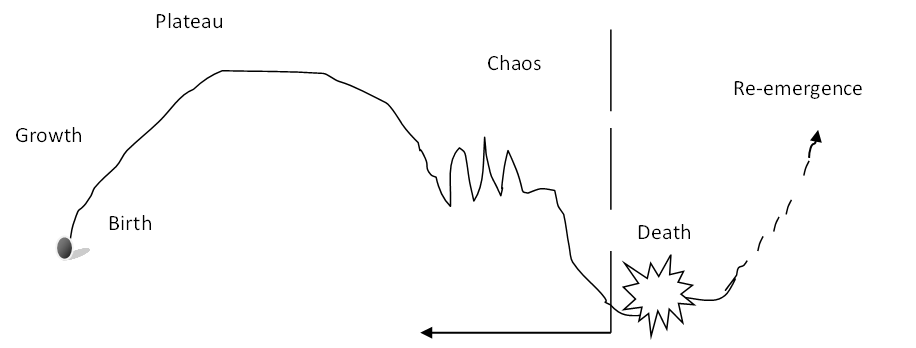
Change Management
I have explored for a definition of ‘change’ and have come to agree with Berg (1979); that much of the present confusion and ambiguity in the field stems from the fact that we actually know very little about the nature of change.
My definition of change is that it is a process that shifts one from its’ current state’ to a ‘different state’. This can be planned or unplanned.
Change is the only constant – Heraclitus, Greek philosopher
Defining change management is tough under any circumstance according to Holland and Skarke (2003)
Change management is a process of aiding an organisation, group or person through change. It is a focused effort to bring about change. The term ‘management’ implies effort to plan and exert the change.
Change management is a structured approach to shifting/transitioning individuals, teams, and organisations from a current state to a desired future state. It is an organisational process aimed at empowering employees to accept and embrace changes in their current business environment.
There are a range of models, approaches and tools that demonstrate the single term ‘change’.
Planned Change: This is when change is planned, deliberate, a product of conscious reasoning and actions.
Emergent Change: Spontaneous and unplanned change. This could result from external factors
Episodic Change: Infrequent, radical, intentional.
Continuous change: On-going, cumulative and evolving
Developmental Change: is one that enhances or corrects existing aspects of an organisation. It may be planned or emergent.
Transitional Change: is episodic, planned, one that seeks to achieve a known desired state that is different from the existing one.
This is based on Lewin’s (1951) three stage process:
- Unfreezing the existing organisation equilibrium
- Moving to a new position
- Refreezing in a new equilibrium
Schein (1987) elaborated on Lewin’s model. Schein sees change as occurring in three stages:
-
- Unfreezing: creating the motivation to change;
- Learning new concepts and new meanings from old concepts;
- Internalising new concepts and meanings.
Applied - Schein’s model of Change

Transformational Change is a radical shift in assumptions made by the organisation and its members. It may result in an organisation that functions in developmental mode, continuously learning, adapting and improving.

In many cases where Transformational Change is in practice, once an organisation gets to the Chaos stage and panic sets in, to avoid ‘Death’ they revert back to Birth stage, this is because the change is not managed effectively.
In order to come out of this loop, a Transitional Change is preferred, applying Schein (1987) elaboration on Lewin’s model: this will see the organisation move from the ‘Old State’ to a ‘New State’.
Approach to Change
I have explored various approaches to change – behavioural approach, cognitive approach, psychodynamic approach and humanistic psychology approach. A behavioural approach places emphasis on how one individual can change another’s behaviour using reward and punishment to reach intended results. If the intended results are not reached, this can be evaluated and managed. If a study involves changing hearts and minds, a behavioural approach to change might be appropriate. To consider ‘rewards’ and ‘punishment’, one has to explore people’s motivation. According to Herzberg (1968), motivated workers give their best performance, which will imply that demotivated workers do not give their best performance. One must consider the impact of ‘rewards’ and ‘punishment’ from both sides.
Leading Change
“Without vision, the people perish”. (Holy Bible; Proverbs 29 verse 18). Christian literature highlights the importance of vision for the existence and survival of a people.. The third discipline of a learning organisation is – building a shared vision (Senge 1990). Building and sharing the vision for change is vital for effective change management as it directs and drives the change. “If you don’t care where you’re going, then it doesn’t matter which way you go.” As quoted by Lewis Carroll. Kotter (1995) refers to Vision in Step 3 – ‘Create a vision for change’ and in Step 4: ‘Communicate the vision’.
The role of leaders in complex change systems according to Wheatley (1999) is to lead through vision, values and ethics; a vision that is co-created and harnesses the organisation’s own self-organising power. Every change process should have a leader.
Looking at organisational metaphors, (Morgan 1986), some senior leaders have approached the change process as a ‘Machine’ – with them defining targets and timescales for completions without any input from the Operations team – who deliver the change programme; except for advising on methods of delivery. This is typical large organisations as change is seen as linear, with no consideration to complex adaptive systems. Change process should be seen as an ‘Organism’, as in my opinion; there must be participation and stakeholder engagement in the change process.
However, there is an element of ‘Machine’ metaphor in the role of the Change Leader, as often they tend to be the chief designer and implementer of the changes, as well as a coach, counsellor and consultant (Cameron and Green 2012).
Resistance to change
Although resistance to change is now generally expected by many change managers, however, they still cannot understand why people do not embrace change. There are a few factors that I have found that contribute to this resistance: lack of vision and lack of skills to engage with the change amongst many others. Schein (1987) suggests that there are two principles for transformative change to work: first, survival anxiety must be greater than learning anxiety, and second, learning anxiety must be reduced rather than increasing survival anxiety.
Engagement
Based on the original theory of reasoned action and planned behaviour, Ajzen (1991: 181) states that “a central factor in the theory of planned behaviour is the individual’s intention to perform a given behaviour. Intentions are assumed to capture the motivational factors that influence a behaviour; they are indications of how hard people are willing to try, of how much of an effort they are planning to exert, in order to perform the behaviour..” This means that for positive outcomes the change leader needs to understand individual motivations and engage with them positively to create a positive behaviour and avoid silent resistance. It is also important to be aware of peer’s opinions.
Identifying Stakeholders
It is important to engage with all stakeholders when managing change to avoid any silent resistance. There is extensive evidence in literature to show that for a planned change to be successful, it is crucial that the stakeholders – those who will be affected by it – are engaged in the planning of that change, e.g. Bennis et al (1985).
Tools that support complex change:
- Storytelling
- Dialogue
- Whole system work
- Open Space technology
- Future Search
These engagement tools, principles and methods should be explored to seek user preferences. The results will be a workable combination that can then be implemented into the developing change model for any study.
My definition of change is that it is a process that shifts one from its current state to a different state.
Author: Blessing Enakimio
